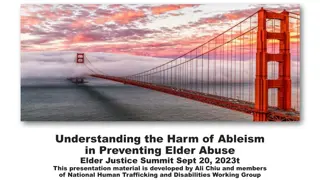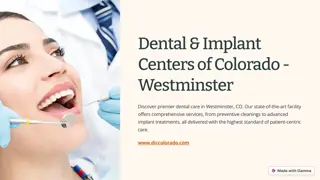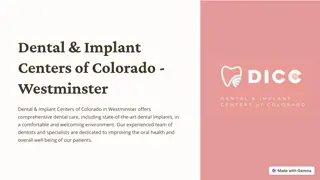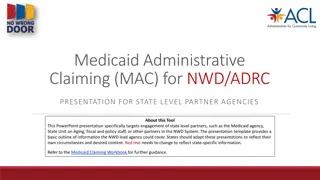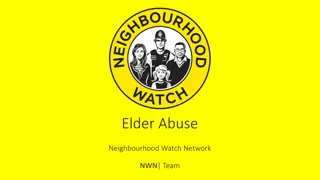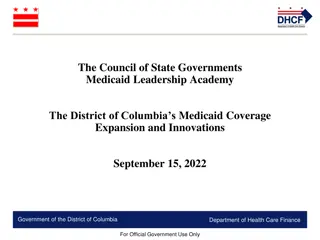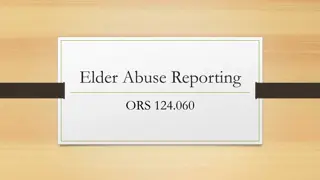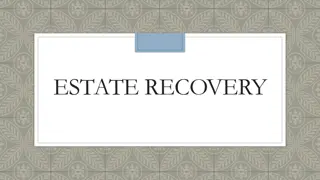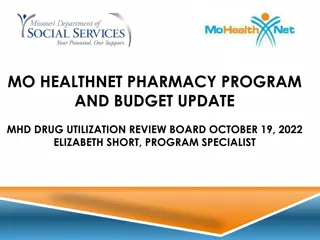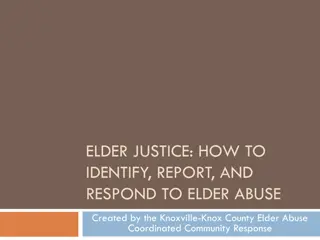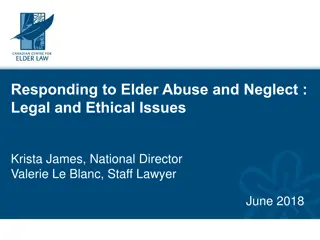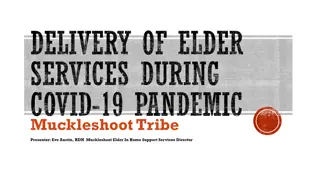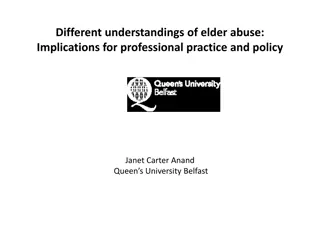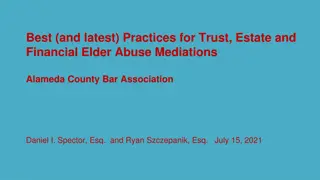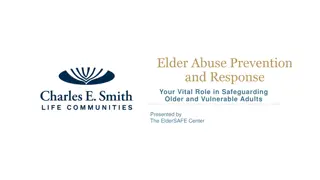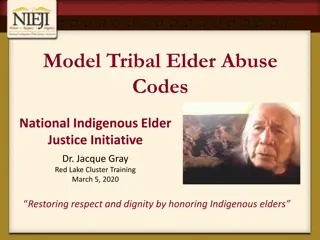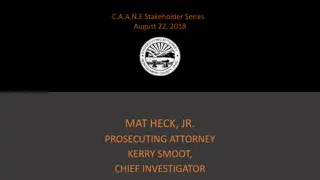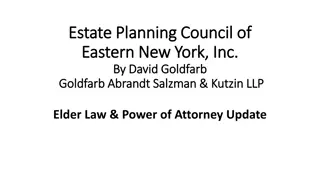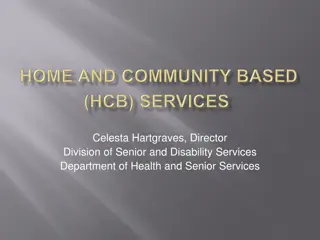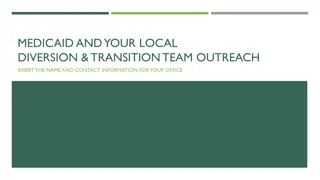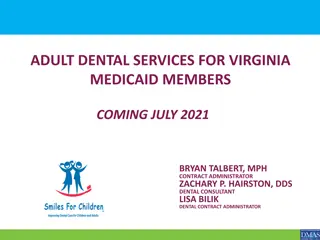Elder Care in 2023: Medicaid and Estate Planning Overview
Explore the intersection of estate and Medicaid planning for elder care in 2023. Learn about asset and income requirements, Medicaid transfer penalties for nursing home applications, and important changes for the upcoming year. Get valuable insights on protecting assets and navigating Medicaid regulations. Contact Elizabeth Forspan, ESQ., for expert legal guidance.
Download Presentation

Please find below an Image/Link to download the presentation.
The content on the website is provided AS IS for your information and personal use only. It may not be sold, licensed, or shared on other websites without obtaining consent from the author. Download presentation by click this link. If you encounter any issues during the download, it is possible that the publisher has removed the file from their server.
E N D
Presentation Transcript
Elder Care in 2023: The Intersection of Estate and Medicaid Planning ELIZABETH FORSPAN, ESQ. December 2022 www.ForspanKlear.com (516) 765-772 eforspan@ForspanKlear.com
LEGAL DISCLAIMER-FORSPAN KLEAR LLP This presentation may be considered Attorney Advertising, and any prior results do not guarantee a similar outcome in the future. This presentation is intended to provide general information and does not provide legal advice nor an invitation for an attorney-client relationship. Receiving information contained in the presentation or contacting Forspan Klear, by any method, shall not create an attorney-client relationship. An attorney-client relationship shall only commence with a mutually executed legal engagement letter between Forspan Klear and the client. Forspan Klear shall not be liable for any action or inaction as a result of relying on content from this presentation. Forspan Klear makes no representations, warranties, claims, promises or guarantees that the information in this presentation, is accurate, complete, current or applicable to your unique legal situation. www.ForspanKlear.com
Medicaid Overview www.ForspanKlear.com
Overview of the Medicaid Asset and Income Requirements New Changes for 2023 1. Asset Rules The Medicaid applicant may keep up to the state applicable Medicaid asset threshold ($16,800 in New York) plus exempt assets (Beginning January 1, 2023,this is being increased to $28,134 per person and $37,908 for a couple) Community Spouse Resource Allowance Income Rules Varies by state (NY: $50 in Nursing Home; $934 at Home) Beginning January 1, 2023, the at-home income allowance is being increased to $1,563 per month! ($2,106 for a couple) Pooled Income Trusts (Available for Home Care)/Qualified Income Trusts A spouse can sign a Spousal Refusal but again, beware of spousal suits! The five-year look-back period applies to Nursing Home Medicaid New 30-month look-back for Community-based Medicaid (Home Care) in New York 2. 3. 4. 5. www.ForspanKlear.com
Medicaid Transfer Penalties: Nursing Home Applications When an individual applies for Medicaid nursing home care, Medicaid will look back 5 years to see what assets the applicant and spouse (if any) had, and what assets were gifted away. If money was gifted during the look-back, Medicaid calculates a so-called penalty period that will cause the applicant to become ineligible for Medicaid coverage for a period of time. Period starts when applicant is institutionalized, applies for Medicaid benefits and is otherwise eligible except for gifts. For example, a transfer of $134,150 within the 5-year lookback period will create a 10-month period of ineligibility (for NYC applicants using the NYC regional rate). www.ForspanKlear.com
The New Medicaid Home Care Rules AGAIN! www.ForspanKlear.com
New Medicaid Home Care Rules NYS FY 2020-21 Budget Adopted 4/1/2020 Covid-19 large factor for changes not taking place immediately Maintenance of Effort requirement, under the Familied First Covid Relief Law Eligibility standards and procedures can be no more restrictive that those that existed on 1/1/2020 if NYS is to receive funds (Federal Covid-19 Stimulus to NYS) Thankfully, spousal refusal for home care was not eliminated www.ForspanKlear.com
New Home Care Rules New 30-month (2.5 year) Lookback Effective Date: October 1, 2020 or April 1, 2021, July 1, 2021, or now January 1st 2023??? WILL THIS ACTUALLY HAPPEN? Because of Maintenance of Effort requirement under the Federal Stimulus Package, the lookback will NOT start until most likely January 1, 2022 APRIL 1, 2024 AT THE EARLIEST Transfers made prior to October 1, 2020 will not be subject to a lookback What does this mean? Phased-In Lookback: For Home Care applications submitted after January 1, 2022 (?) and after, there will first be a lookback going back to October 1, 2020 What about applications that are submitted prior to the new anticipated effective date? Should we take action? If there is a Home Care need, or an anticipated need, then applying now is likely still a smart move www.ForspanKlear.com
New Home Care Rules How does it work? - For every $13,415 (NYC) in non-exempt transfers made during the lookback there will be a one- month penalty period (uses the regional nursing home rates for now) - Very similar process to a nursing home application - This is the first time New York will have a lookback for home care! - There are no regulations or guidance that have been issued yet www.ForspanKlear.com
New Home Care Rules Who is grandfathered in? Those already receiving services as of the effective date Those who apply before the effective date, even if approved after the effective date IMPORTANT: The lookback will apply to an increase in coverage for those who previously had Medicaid and are now requesting Long Term Care services they must submit a Supplement A. How will the phase-in of the lookback period work? As mentioned, transfers before October 1, 2020 will not be subject to a transfer penalty If you apply on January 1, 2023 there will be a 27-month lookback to October 1, 2020 Add one month until you reach April 1, 2023, when the lookback will be the full 30 months www.ForspanKlear.com
New Home Care Rules Exempt Transfers Will the Nursing Home transfer exceptions apply to home care apps? YES 1. Spouse 2. Disabled/Blind Child 3. SNT for disabled person under age 65 4. Transfer of an exempt assets e.g. Holocaust restitution payments 5. Asset sold for FMV 6. Transfer made for purposes other than to qualify for Medicaid 7. Returned assets/gifts 8. Assets used to purchase compliant annuities, life estate, prom notes, loans or mortgages (subject to the SSL rules) www.ForspanKlear.com
New Home Care Rules What about a transfer of the home? - The Department of Health has said that the same exemption for NH will apply for Home Care: - Transfers to spouse, disabled child, caregiver child, sibling with equity interest - But will a transfer of the house be exempt? - Unclear - If value is under the equity limitation (currently $955,000), then exempt for Medicaid if applicant lives there (no limit if spouse, disabled or minor child lives in the home) - Since home is exempt for community Medicaid, then we hope a transfer of the home will be treated as a transfer exclusively for a purpose other than to qualify for Medicaid www.ForspanKlear.com
Other Key Changes ADL Requirements Assistance with more than 2 ADLs required or persons with dementia/Alzheimer s diagnosis who must need supervision with more than 1 ADL Assessments New Assessment Tool to be approved by DOH Evidence-based validated assessment instrument A uniform tool, not specific to each MLTC Qualified Independent Physician Personal care and CDPAP services need to be prescribed by a qualified independent physician selected or approved by the DOH Will add significant delays; physician unfamiliar with patient/diagnosis Independent Panel Extra review of high-hour consumers are they capable of living in the community? Might be required for 12+ hours of services per day Independent Assessor to Determine Hours Will determine how much Personal Care and CDPAP to be authorized Will replace MLTC/DSS determining hours No more Level 1 Housekeeping Serious CDPAP restrictions www.ForspanKlear.com
Major Key Changes: Medicaid Redesign Team II 1. Independent Assessor for Personal Care Services and CDPAP Effective Date: May 16, 2022 for MLTC Medicaid enrollment and October 1, 2022 for Immediate Need 2. New minimum 3 ADL Requirement Delayed until Public Health Emergency ends May be delayed until March 31, 2025 (still unclear!) 3. 30-Month Lookback Delayed until Public Health Emergency ends (see above) www.ForspanKlear.com
Major Key Changes: Medicaid Redesign Team II New York Independent Assessor (NYIA) for Personal Care Services and CDPAP Now replaces the Conflict Free evaluation NYIA will include AT LEAST 2 assessments Will be required for all requests for increases in services NYS has contracted with Maximus Health Services, Inc. to perform NYIA assessments As of May 16, 2022, all new enrollees in PCS and CDPAP will have the NYIA www.ForspanKlear.com
Major Key Changes: Medicaid Redesign Team II Who will not need a NYIA Assessment? Medicaid recipient already receiving services Annual reassessments and requests for increases will be phased in at a later date www.ForspanKlear.com
Major Key Changes: Medicaid Redesign Team II How many assessments will actually take place before home care services begin? At least 3! Previously there was one conflict-free assessment before the MLTC assessment Now first there will be a Community Health Assessment (CHA) or Independent Assessment (IA) which uses the UAS-NY tool THEN there will be an Independent Practitioner Panel (a Maximus doctor, NP or PA) who will schedule the Clinical Appointment (CA) the examination by the Independent Practitioner Panel (IPP) and the Practitioner s Order (PO) THIS WILL DECIDE IF THE APPLICANT IS ELIGIBLE TO ENROLL IN MLTC If the PO finds that the applicant is eligible to enroll in MLTC, then the MLTC plan MUST USE THE NYIA AND IPP assessments to develop a plan of care If the plan is for more than 12 hours per day, then an Independent Review Panel must conduct a high needs review At a minimum, there will need to be a CHA and CA assessment even before the MLTC assessment www.ForspanKlear.com
Some Tax Issues in Medicaid Planning www.ForspanKlear.com
Tax Implications of Outright Transfers vs. Transfer to Trusts Transfers of Real Property Including Principal Residence Transfer of Liquid Assets Basis Issues www.ForspanKlear.com
Transfers to Trust Outright Transfers (Gifts) Carryover Basis No Sec. 121(a) for Donor Creditor Issues Pre-deceased child/Donee Divorce Basis Step-Up Sec. 121(a) is available for Grantor(s) Asset Protection www.ForspanKlear.com
Irrevocable Medicaid Asset Preservation Trust Trust Requirements: Must be Irrevocable Settlor should not serve as Trustee (best practice) Any principal or income that can be distributed to the Settlor or Settlor s spouse will be considered available for Medicaid purposes Discretionary payments to Settlor / Settlor s spouse will be available even if subject to an ascertainable standard HEMS will not be acceptable for Medicaid purposes www.ForspanKlear.com
Irrevocable Medicaid Asset Preservation Trust cont. Advantages: Considered a completed transfer for Medicaid purposes Decision-making can be easier and more efficient Can provide protection against children s creditors Income tax benefits Real Estate tax exemptions IRC Section 121 Exemption can be maintained Can preserve step-up in basis upon Settlor s death Can reserve limited power of appointment to make limited changes to beneficiaries www.ForspanKlear.com
Irrevocable Medicaid Asset Preservation Trust cont. Disadvantages: Loss of control/independence More costly / complicated Difficult to mortgage real estate Excess income considerations i.e. Does the trust provide income to the Settlor? Will that result in high spend-down if Medicaid is needed at a later date If so, consider giving income to another beneficiary Beware high trust income tax rates www.ForspanKlear.com
Transfers of Real Property Including Principal Residence to a Trust Ability to live in home Ability to receive rental income (if desired) May direct Trustees to sell property and exchange for new property Section 121 Exclusion Maintain basis step-up Asset included in estate of Settlor Limited Power of Appointment Maintain degree of control/independence www.ForspanKlear.com
IRC Section 121(a) Up to $250,000.00 of gain excluded from gross income On sale/exchange of property Property owned and used as principal residence for periods aggregating 2 years or more www.ForspanKlear.com
Section 121- Ownership Requirement Single owner entity disregarded for federal tax purposes (i.e. single member LLC) satisfies requirement Grantor trusts satisfies requirement Limited partnership does not satisfy requirement Regs 1.121-1(c)(3) www.ForspanKlear.com
Transfers of Liquid Assets Transferring Brokerage Accounts to a Trust Low basis versus high basis assets will inform decision in many cases Maintain step-up for low basis assets Consider income tax consequences for beneficiaries Consider Grantor Trust so Grantor will pay income taxes regardless of who receives income Consider income being generated for Medicaid purposes www.ForspanKlear.com
Transfers of Liquid Assets Transferring a Non-qualified Annuity to a Trust Cash value is considered an asset for Medicaid purposes: non-exempt asset Certain pre-DRA 2005 annuity rules apply: Medicaid may treat as income stream and not asset, but must meet DRA requirements Goal is to maintain tax-deferred status May only be transferred to a grantor trust IRC Section 72(u) www.ForspanKlear.com
Annuity Contract- IRC 72(u) If held by a person who is NOT A NATURAL PERSON, generally not treated as an annuity contract TRAP: Income on the contract for any taxable year of the policyholder shall be treated as ordinary income received or accrued by the owner during such taxable year Exception: Will remain tax deferred if held by a trust as an agentfor a natural person. Will depend on the beneficial ownership i.e. is the beneficial owner a natural person? Legislative history and multiple PLRs suggest that where annuity held in trust for the benefit of a natural person, annuity is treated as owned by the natural person for tax deferral purposes. Consider two trusts in the case of a married couple www.ForspanKlear.com
Tax Consequences of Medicaid Trusts Income Taxes Who is paying the income taxes? Almost always structured as Grantor Trusts Estates Taxes Do people who engage in Medicaid planning generally need to worry about estate taxes??? Real Estate Tax Exemptions Can be a significant help with expenses for seniors www.ForspanKlear.com
Real Estate Tax Exemptions Veteran s Exemption Senior Citizen s Exemption Enhanced STAR Exemption www.ForspanKlear.com
Estate Tax Exclusions Federal: $12,920,000 per person 12/31/2025 Sunset Portability Unified Credit New York: $6,540,000 Cliff No Portability Three year clawback on gifts www.ForspanKlear.com
Annual Gift Tax Exclusion Annual Gift Exclusion:$17,000 ($34,000 for a married couple) However, this amount is considered a gift for Medicaid purposes and will cause a period of ineligibility www.ForspanKlear.com
Where Good Estate Planning Equals Bad Medicaid Planning Annual Gift Tax Exclusion Be careful! Revocable Trusts Irrevocable Trusts Life Estates CSTs Certain Powers Trustee Discretion 5X5 Power HEMS www.ForspanKlear.com
Revocable Trusts General Purposes: Avoiding Probate and Privacy Assets held in a revocable trust are considered available assets for Medicaid purposes as if the Grantor owned the property outright Will it be the new norm for protection against Medicaid Estate Recovery? www.ForspanKlear.com
Irrevocable Trusts Ensure that no principal goes to the Grantor HEMS (health, education, maintenance and support) is not good 5 x 5 power is not good Ensure Trustee discretion Be careful with the ability to swap assets and changing Trustees www.ForspanKlear.com
Life Estates Basis Step-up Section 121(a) is limited If home is sold during life, it can create a Medicaid ineligibility period Caretaker Child exemption Transfer between spouses www.ForspanKlear.com
Questions? www.ForspanKlear.com
Elder Care in 2023: The Intersection of Estate and Medicaid Planning ELIZABETH FORSPAN, ESQ. December 2022 www.ForspanKlear.com (516) 765-772 eforspan@ForspanKlear.com


